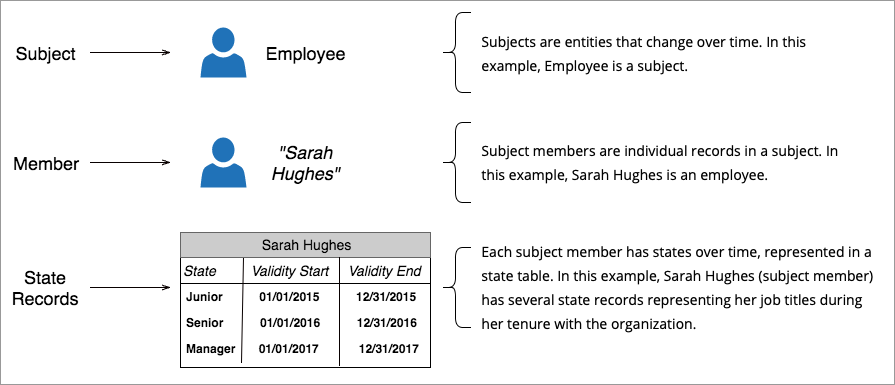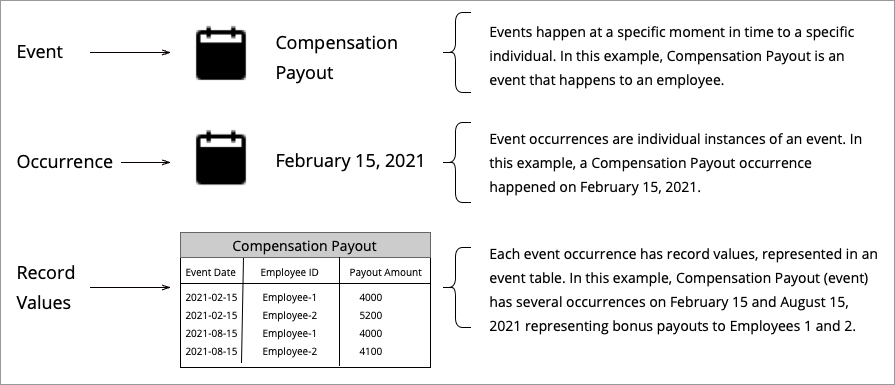Analytic Objects
Learn more about analytic objects in Visier.
Overview
An analytic object is a container that stores specific data and represents what you want to analyze or aggregate data for, like applicants, employees, pay change events, interviews, and even employee skills. It is similar to a relational table where data is structured into rows and columns: the analytic object is the table, its attributes are the columns, and each row represents a record.

Visier organizes the analytic model around analytic objects because these objects connect to your data meaningfully to create new understandings of your data. Analytic objects are the target objects for data uploading, meaning that your data gets connected to specific analytic objects in Visier. After data is available in Visier and connected to analytic objects, you can use Visier's platform to perform aggregations and analysis on your data.
Analytic object types
Analytic objects are categorized into specific analytic object types: subjects, events, overlays, and internal comparisons. Each analytic object type serves a specialized purpose, such as depicting a data record over time or a record change.
- Subject: A subject is an entity that changes over time, for example, employees, applicants, requisitions, learning items, and sales opportunities. For more information, see Subjects.
- Event: An event is something that happens at a specific moment in time and may be associated with one or more individuals. In Visier, events happen to subjects. For more information, see Events.
- Overlay: An overlay contains already-aggregated values and are used for benchmarking data and measuring KPIs, among other uses. Because overlays contain aggregated data, there is no information about individual data points. For more information, see Overlays.
- Internal comparison: Internal comparisons are a type of analytic object that allows users to compare themselves against internal groups such as their peers, their manager's team, or their organization as a whole. For more information, see Internal Comparisons.
Tip:
- To learn more, take the Visier University eLearning course: Creating analytic objects.
- To retrieve a list of all analytic objects in your solution, see Data Model API.
Analytic object components
An analytic object contains all instances of the thing it represents; for example, the Employee subject contains data for all employees in your organization. Each specific employee within your organization is a "member" of the Employee subject. Each employee has attributes that describe it, like an employee's Job Name, Tenure, or Start Date. In the next sections, you will learn about analytic object members, occurrences, and attributes.
Analytic object members and occurrences
To refer to specific data records in an analytic object, you can reference "members" and "occurrences".
A specific data record within a subject is a "member"; for example, an Employee member represents one employee (like Sarah Hughes). Each member has states over time, such as an employee's job throughout their tenure at the organization.

A specific data record within an event is an "occurrence"; for example, a Compensation Payout occurrence represents a payout of compensation (like a bonus payment on February 15, 2021). Each occurrence has record values that describe the event, such as the event date, the employee ID that the event occurred on, and the payout amount.

Overlays and internal comparisons do not have members or occurrences because their data is pre-aggregated and cannot identify individual data records.
Attributes
Attributes are a characteristic of an object. For example, an attribute of Employee could be Gender, Tenure, or Manager Status, or an attribute of Compensation Payout could be Event Date, Employee ID, or Payout Amount.
Attributes are categorized into specific attributes types: properties, dimensions, and concepts.
- Property: Properties are attributes of analytic objects that add further detail to an analytic object, like adding full names, birth date, compa ratio, and start dates to describe an employee in your organization. For more information, see Properties.
- Dimension: Dimensions are attributes of analytic objects that organize data values into a list or hierarchical structure. Dimensions allow you to slice and dice can datasets for dynamic analysis, like understanding which age ranges (dimension) are experiencing the highest turnover (metric). For more information, see Dimensions.
- Concept: Concepts are attributes of analytic objects that divide subject members and event occurrences into a subset. Concepts are configured using properties and dimensions to standardize information, such as defining employee movement or diversity factors. For more information, see Concepts.
Analytic object references
The analytic model can consist of multiple analytic objects. In some cases, it may be useful to connect the information stored in one subject with another subject or event. Subject references are special properties that establish the relationship between subjects and events in the analytic model. This allows members of different subjects to link to one another through a forward or reverse reference, providing an additional layer of detail for the relationship between objects. For example, you may want to look at Applicant data when analyzing employees to understand where your top talent was sourced. In this example, the Employee object references the Applicant object to connect an Employee's data to its data as an Applicant, if available. For more information, see References.
To view an entity relationship diagram (ERD) of the references between analytic objects, navigate to Model > Analytic Objects in a project and click Diagram. For more information, see Entity Relationship Diagram.
In this section
